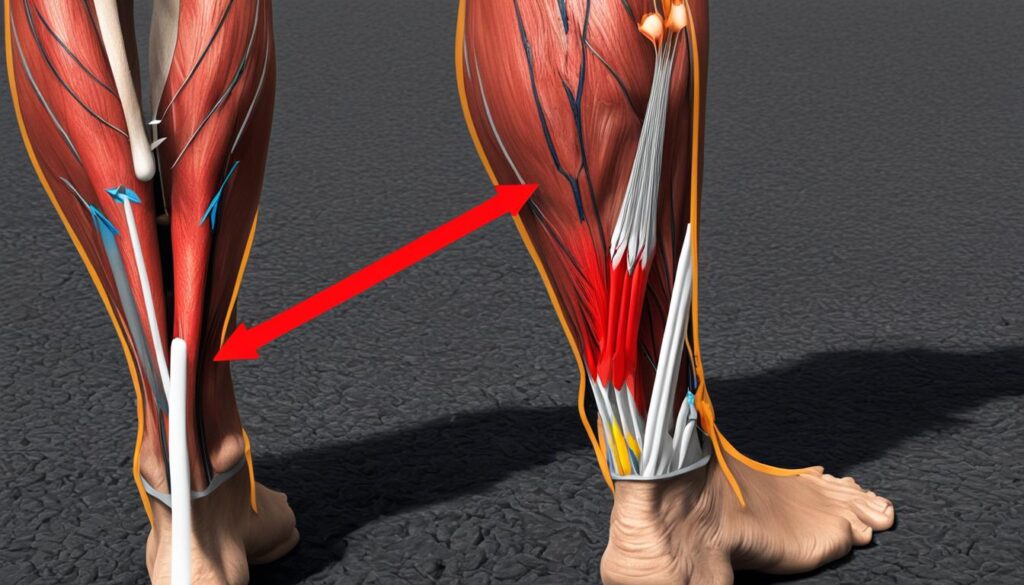You’re in the middle of a great workout, crushing your fitness goals. Suddenly you’re hit with an intense pain in your calf. A muscle cramp. Often known as a ‘charley horse,’ this involuntary and painful contraction of your calf muscles throws a wrench in your plans and leaves you in discomfort. It’s a common occurrence that many of us have experienced at some point, but did you ever stop to wonder if there’s a way to reduce the risk of these cramps? Indeed, there are many methods to prevent these unexpected nuisances.
Well, we’ve got good news! By understanding your body and practicing certain preventative measures, it’s possible to minimize the risk of calf cramps.
In our guide we’ll examine how to avoid calf cramps, explore the various common causes of calf muscle cramps, and provide simple, practical tips that can offer significant relief. We aim to help you comprehend exactly what a calf muscle cramp is, what triggers it, and above all, how to prevent it from disrupting your routine.
Key Takeaways
- Understand what calf muscle cramps are and their potential triggers.
- Dehydration, muscle overuse, and mineral depletion are amongst the most common causes of calf cramps.
- Implementing calf cramp prevention methods such as regular hydration, stretching and a balanced diet can help reduce the risk of cramps.
- Knowing how to identify and manage risk factors can also greatly aid in calf muscle cramp prevention.
- Though a minor and common issue, consistently severe or frequent cramps may warrant a visit to a healthcare provider.
Understanding Calf Cramps: Causes and Common Triggers
The sudden, uncomfortable sensation that seizes your calf muscle without warning often leaves you in utter discomfort, on the lookout for ways to prevent calf cramps. To fend off this unwelcome visitor, it’s important to understand the different calf cramp triggers that could be at play.
Insufficient Blood Flow and Nerve Compression
One of the key factors that could lead to calf muscle cramps is insufficient blood flow to the legs. This could be associated with overexerting the muscles or standing for a prolonged period. Similarly, nerve compression located in the spine can provoke calf pain, leading to cramps. This often worsens when you are in a certain position for a long period.
Nutritional Deficiencies Affecting Muscle Function
Our diet plays a significant role in our overall health and importantly, the calf muscle function. Nutritional deficiencies, precisely low levels of potassium, calcium, or magnesium, can set the stage for cramping. Incorporating nutrient-rich food in your diet could be a simple step towards reducing the occurrences and you’d be one step closer to prevent calf cramps.
Dehydration and Electrolyte Imbalance
Another common trigger for calf cramps is dehydration and an imbalance of electrolytes. After a hardcore workout, if the body does not receive enough fluids, it can lead to an imbalance squeezing your calf muscles into a cramp.
If you’ve wondered why calf cramps often occur unannounced in the middle of the night or a gym session, chances are one of these triggers might be involved.
| Causes | Description |
|---|---|
| Insufficient Blood Flow | Reduced blood supply due to muscle overuse or prolonged standing. |
| Nerve Compression | Compression in the spinal nerves that can lead to nerve compression calf pain. |
| Nutritional Deficiencies | Deficiencies in essential minerals like potassium, calcium, or magnesium. |
| Dehydration | Lack of fluids leading to electrolyte imbalance. |
Remember, most calf cramps are harmless and can resolve on their own. However, if recurrent, they warrant a further look into these triggers. Knowing what causes your calf cramps is a significant step not just towards treatment but also prevention.
Identifying Risk Factors for Calf Muscle Cramps
Preparing ourselves to adequately combat calf muscle cramps begins with understanding the associated risk factors for calf cramps. Our aim is to provide insights into each risk category that contribute to these bothersome contractions, enabling readers to take proper preventive measures.

Our discussion draws attention to the role of older age muscle cramps in this context. Due to the gradual loss of muscle mass in older people, they are particularly prone to calf cramps. Poor physiologic fitness can lead to rapid muscle fatigue, another common trigger for cramps. Excessive sweating, often experienced during intense physical activity, may also contribute by depleting the body’s salt and mineral content, thereby encouraging muscle cramping. Women who are pregnant frequently report calf cramps, likely due to additional weight and pressure on the calf muscles.
Several medical conditions and lifestyle factors also play a part. Diabetes and calf cramps often occur together, with high sugar levels leading to nerve damage that triggers cramping. Neurological issues such as peripheral neuropathy can also result in calf cramping, as can circulatory problems. Even carrying excessive body weight can be a contributing factor.
- Older age – Decreased muscle mass
- Poor physical condition – Rapid muscle fatigue
- Excessive sweating – Depletion of salt and minerals
- Pregnancy – Additional strain on calf muscles
- Diabetes – High sugar levels leading to nerve damage
- Other medical conditions – Particularly neurological and circulatory issues
- Being overweight – Additional pressure on muscles
Identifying and understanding these risk factors provide a cornerstone for effective strategies in preventing calf muscle cramps. In the following sections, we will further explore practical steps towards mitigating these risks and effectively managing calf muscle health.
Best Practices for Calf Cramp Prevention
By implementing essential habits, such as suitable hydration, frequent muscle stretching, and eating a nutrient-dense diet, you can considerably lower your chances of experiencing calf cramps. Here are the effective ways to prevent calf cramps.
Hydration: A Key Element in Muscle Health
Hydration for calf health is vital. When your body doesn’t get enough fluids, particularly during intense workout sessions or hot weather, your chances of suffering from calf cramps increase. It is therefore crucial to drink plenty of water, caffeine-free beverages, and consume foods that have high water content.
Stretching and Muscle Conditioning
Another powerful tool in your arsenal for calf cramp prevention is stretching. Stretching both before and after exercise helps to keep muscles flexible, preventing sudden contractions that lead to cramps. Moreover, daily stretching, especially before sleep, can significantly reduce the occurrence of night-time cramps.
Adequate Mineral Intake for Muscle Maintenance
The lack of specific minerals in your diet can trigger calf cramps. Consuming foods rich in potassium, calcium, and magnesium can help maintain healthy muscle function and avoid cramps. Add bananas, oranges, almonds, soybeans, and dairy products to your diet to ensure you’re getting these essential minerals in adequate amounts.
Calf Cramp Prevention Methods: Proactive Lifestyle Adjustments
Overcoming disruptive and painful calf cramps requires deliberate lifestyle changes. Among the best practices for calf cramp prevention, the first and foremost is maintaining a good physical condition. Regularly participating in exercises which target and condition the body as a whole, including the calf muscles, can significantly lower the risk of muscle spasms.
Just as important is employing the right warm-up techniques prior to physical activity to condition your muscles and safeguard yourself from cramps. Specific warm-ups tailored for calf muscles include dynamic stretching exercises like ankle circles, calf raises and light jogging.
Footwear also plays a critical role in calf cramp prevention. Shoes that offer ample support to your feet, particularly during workouts, are crucial in preventing these troublesome cramps. Your shoes should offer good arch and heel support to alleviate tension in your calves.

Another crucial yet oftentimes overlooked practice in the battle against calf cramps is weight management. Excess body weight can put undue strain on muscles including the calves, facilitating cramps. A balanced diet coupled with regular physical activity can help in maintaining optimal weight.
The following table outlines some techniques to avoid calf cramps:
| Prevention Methods | Details |
|---|---|
| Maintaining Physical Fitness | Regular exercise, especially targeting calf muscles, can reduce the incidence of cramps. |
| Warm-up before exercise | Proper warming-up techniques can condition muscles and prevent cramps. |
| Choosing Suitable Footwear | Footwear with good arch and heel support can alleviate tension in calves. |
| Weight Management | Maintaining optimal weight to reduce the strain on calf muscles. |
Adopting these lifestyle changes can drastically reduce the occurrence of calf cramps. These preventative measures help in laying a strong foundation for a cramp-free, limber and active life
Treatment and Relief for Acute Calf Cramps
Dealing with an unexpected calf cramp can be a painful and distressing experience. But don’t worry, there are certain immediate actions that can offer significant relief for calf muscle pain and techniques that can effectively provide treatment for calf cramps.
Immediate Techniques to Alleviate Pain
When a calf cramp strikes, you can quickly mitigate the pain with simple yet effective methods. Start by gently stretching the affected muscle. A light massage can also help to relax the tense muscle coiling from the cramp. Lastly, ensuring adequate hydration is key to prevent muscle exhaustion and subsequent cramps.
When to Seek Medical Attention for Recurring Calf Cramps
While occasional calf cramps may be common, frequent and severe episodes could be a sign of underlying health issues. Do seek immediate medical attention for calf cramps if they are associated with symptoms like leg swelling, redness, or muscle weakness. Further investigation may be needed to identify if the cramps are symptoms of a more serious medical condition.
Heat Therapy and Its Effects on Muscle Tension
Heat therapy for muscle cramps has proven to be quite beneficial. It promotes blood flow, aids in muscle relaxation, and can provide rapid relief from the discomfort of a calf cramp. For ease and convenience, you can opt for heat wraps, hot water bottles or a warm towel applied to the affected area.
| Remedy | Description | When To Use |
|---|---|---|
| Gentle Stretching | Stretch the affected muscle gently to release tension. | At the onset of a cramp. |
| Massage | Apply light pressure and rub the area experiencing the cramp. | During a cramp. |
| Hydration | Drink water or electrolyte-rich drinks to prevent muscle exhaustion. | Before, during and after physical activity. |
| Medical Attention | Consult a healthcare professional for persistent, severe, or unexplained cramps. | When cramps are associated with other worrying symptoms. |
| Heat Therapy | Apply a warm wrap or towel to the cramping muscle. | During or after a cramp to relieve discomfort and promote relaxation. |
In conclusion, calf cramps, though painful, can be addressed and managed effectively using these vested methods. For those that frequent, never hesitate to seek professional help, as these could be indicative of underlying health concerns. Remember to stay hydrated, relax, and maintain a healthy, mineral-rich diet. Happy trails!
Conclusion
While calf cramps can be a troublesome experience, gaining an understanding of their causes, risk factors, and methods for effective calf cramp prevention is invaluable in learning how to manage them and reduce their occurrence. The cause of these cramps can often be traced back to factors such as nerve compression, nutritional deficiencies, and dehydration. Recognizing these triggers is the first step in avoiding calf muscle cramps.
Practices such as preventative stretching, regular hydration, and careful attention to dietary habits all integrate seamlessly into day-to-day routines, serving to mitigate the risk of calf cramps and maintain overall muscle health. These key tools in managing muscle health can provide significant relief and a greater sense of control over one’s wellbeing.
In cases where calf cramps persist or become severe, it’s critical to seek medical advice. More often than not, these cramps are harmless and temporary, but in rare cases, they may indicate a more serious underlying health condition requiring professional care. The combination of personal management strategies and professional guidance can ultimately lead to a healthier, cramp-free lifestyle.





